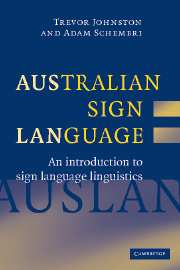Book contents
- Frontmatter
- Contents
- Acknowledgements
- Conventions for sign notation
- 1 Signed languages and linguistics
- 2 Auslan in social context
- 3 Auslan and other signed languages
- 4 Phonetics and phonology: the building blocks of signs
- 5 Morphology: sign formation and modification
- 6 Lexicon: the structure of Auslan vocabulary
- 7 Syntax: the structure of sentences in Auslan
- 8 Semantics and pragmatics: sign meaning and sentence meaning
- 9 Discourse: structure and use above the sentence
- 10 Issues in the study of signed languages
- References
- Index
6 - Lexicon: the structure of Auslan vocabulary
Published online by Cambridge University Press: 02 December 2009
- Frontmatter
- Contents
- Acknowledgements
- Conventions for sign notation
- 1 Signed languages and linguistics
- 2 Auslan in social context
- 3 Auslan and other signed languages
- 4 Phonetics and phonology: the building blocks of signs
- 5 Morphology: sign formation and modification
- 6 Lexicon: the structure of Auslan vocabulary
- 7 Syntax: the structure of sentences in Auslan
- 8 Semantics and pragmatics: sign meaning and sentence meaning
- 9 Discourse: structure and use above the sentence
- 10 Issues in the study of signed languages
- References
- Index
Summary
In the previous chapter, we discussed the various types of morphological processes that can create new signs or modify existing signs in Auslan. In this chapter, we describe the structure of the Auslan lexicon, and the various different categories of signs that exist in the language.
The Auslan lexicon
Linguists believe that users of a particular language have a mental lexicon (i.e., a dictionary in the mind) that contains the words and morphemes of that language, along with their meanings and other important types of linguistic information (such as their word class, see Chapter 7). Together with the mental grammar (which contains the rules for combining the words and morphemes into complex lexical items, phrases and sentences), the mental lexicon enables users of a language to produce and comprehend utterances in that language.
An individual's mental lexicon, however, could not possibly contain all the words of a language, as the list is very large (see the discussion of creativity in Chapter 1). New words are being created all the time, many of which do not become established lexical items in the language. This aspect of the language means we need to draw a distinction between potential signs in Auslan and actual signs (cf. Spencer, 1991). Actual signs are those which have occurred and with which most of the signing community is familiar, as opposed to the limitless number of potential signs which are possible. In the signed language linguistics literature, the lexicon of actual (or lexicalised) signs is widely known as the frozen, established or core lexicon (e.g., Supalla, 1986; Sutton-Spence & Woll, 1999; Brentari & Padden, 2001).
- Type
- Chapter
- Information
- Australian Sign Language (Auslan)An introduction to sign language linguistics, pp. 157 - 188Publisher: Cambridge University PressPrint publication year: 2007

